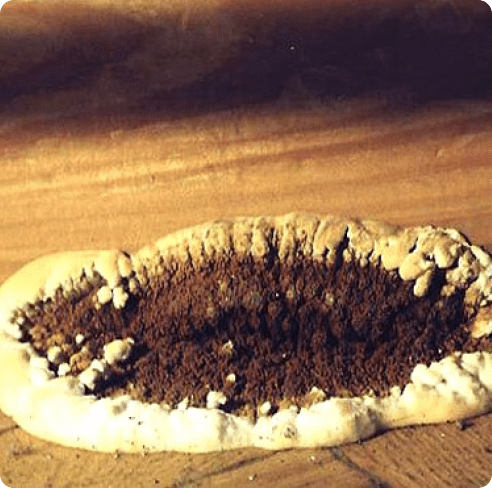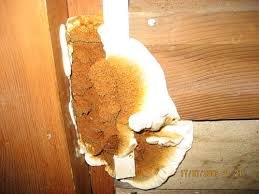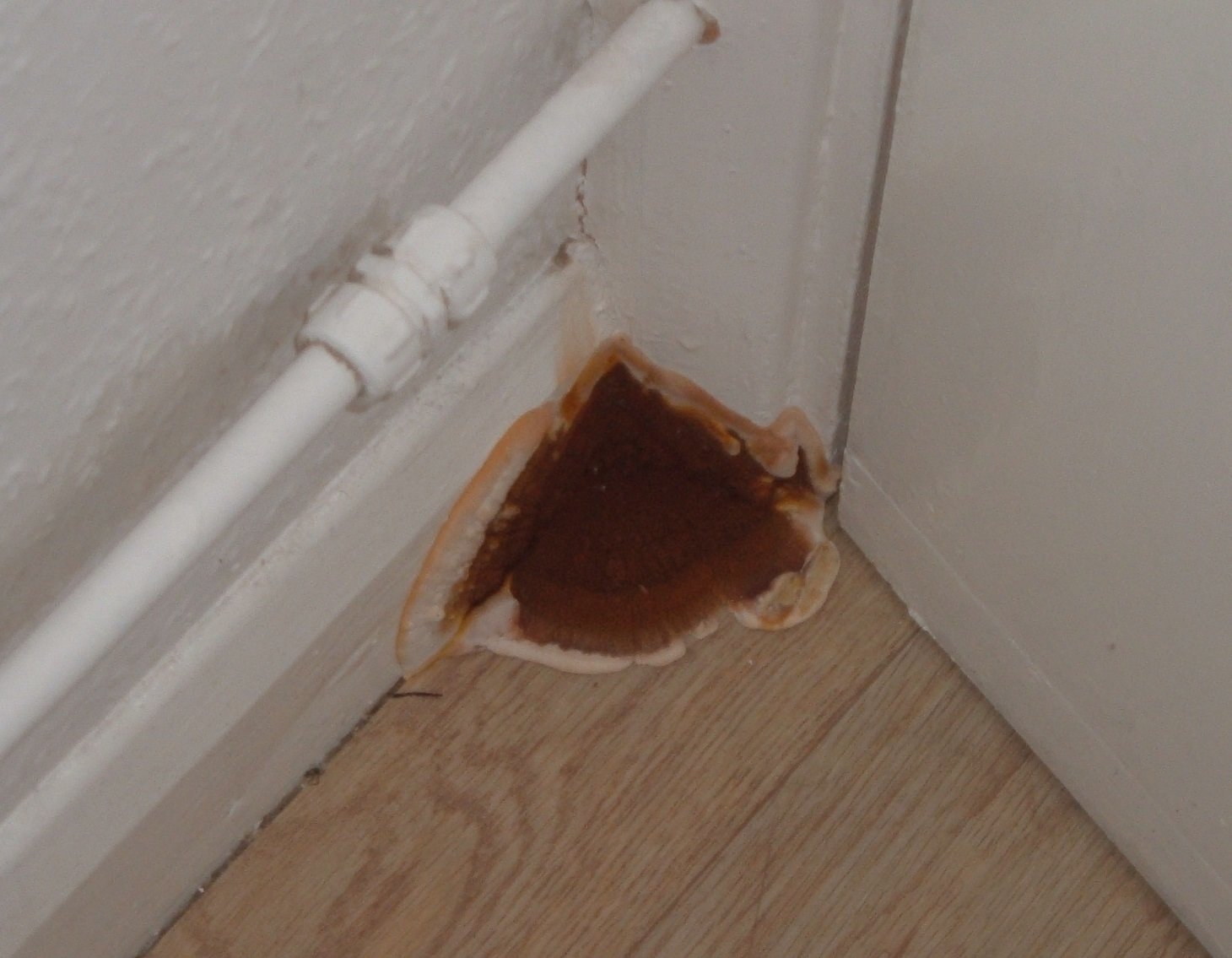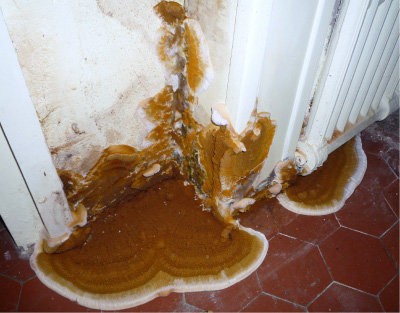House mushroom (Serpula lacrymans)
- Diviziona: Basidiomycota (Basidiomycetes)
- Fizarana: Agaricomycotina (Agaricomycetes)
- Kilasy: Agaricomycetes (Agaricomycetes)
- Kilasy: Agaricomycetidae (Agaricomycetes)
- Karazana: Boletales (Boletales)
- Fianakaviana: Serpulaceae (Serpulaceae)
- Rod: Serpula (serpula)
- Type: Serpula lacrymans (House mushroom)

This fungus belongs to the category of harmful fungi that destroy trees.
Its other names:
It settles on felled dead trees, and is especially dangerous when breeding in various buildings. Once settled in a tree, it can easily and quickly destroy wooden parts.
house mushroom has a well-developed ability (to varying degrees inherent in all mushrooms) to form a powerful mycelium even in completely unsuitable conditions for fruiting. Such conditions include stagnant stale air, high humidity, lack of light. In the presence of these factors, the fungus develops very abundantly and quickly in the form of a barren form and actively conducts destructive activity.
As a rule, this fungus spreads in basements and cellars, where it is humid and stuffy, on the bottom of the floorboards, at the base of the beams. He feels especially good if the floor is directly on wet soil.
At the beginning of the development of the fungus, small white dots appear on the tree, which eventually merge into mucous spots or woolly tender plaques, then a plexus appears, similar to a silver web. Gradually, it spreads more and more over the surface of the tree, thickens, acquires a leafy structure, a silky sheen and an ash-gray color.

Along the edges of the fungus, thin threads are formed that pass through the spurs, with the help of which the fungus, as it were, crawls in search of food through small cracks and holes in the walls. Thus, he moves from one part of the house to another. Sometimes such destructive work can lead to the destruction of the entire house and its fall.
house mushroom may sometimes act in conjunction with other representatives of fungi, such as Polyporus vaporarius, Polyporus destructor and others. Most often, house fungus affects conifers, but can also damage deciduous trees, such as oak.
Effect on wood
When conducting research, R. Hartig found that the fungus secretes special enzymes that are capable of dissolving organic wood compounds at a great distance from the fungus. As a result, the tree turns into a form that the fungus is able to assimilate. In addition, these enzymes are capable of dissolving ash constituents in cell membranes upon direct contact with hyphae. As a result of all these processes, the destruction of the tree occurs.
Gradually, the wood turns brown, turns into dust, and if it is soft enough in its fresh state, then as a result of the action of the fungus, it dries out, becomes brittle and brittle. Particularly easy holatra hazo destroys a floor covered with oil paint, because in this case the underside of the floor is completely closed from light and protected from drying out.
The fact that such a fungus appeared on the wood can be understood by the black spots that appear on the upper surface, and if the wood is covered with glue paint, then yellowish fluffy areas are formed on it, located separately from each other.
If wood infected with tree fungus is knocked on, a dull sound is obtained, and when pressed, it easily breaks. The affected tree absorbs water very actively, becomes too hygroscopic, so moisture from below can pass even to very remote parts of the house. In addition, the mycelium of the fungus itself has the ability to easily conduct moisture and transfer it to dry wood, so even in the driest rooms it can become very damp and it will be impossible to live in them.
In addition, there is one more unpleasant moment: the fruiting bodies of the fungus, during decomposition and decay, emit a characteristic and very unpleasant odor, which is also harmful to health.
According to research by Polek and Goeppert, tree fungus can contain between 48 and 68% water.

If the mycelium comes out through cracks or cracks into fresh air and light, then the fruiting bodies of the fungus begin to form. They are lamellar, plate-shaped, wide, can reach a size of up to a meter, have a leathery fleshy texture. At the beginning of development, the fruiting bodies are white, then they become reddish-yellow, and at the end they are rusty-brown. Above, they have wriggling worm-like folds on which spores are located, and below they have a fibrous-velvety structure with white swollen edges. The edges of the fruiting bodies secrete transparent drops of liquid, which later becomes cloudy, acquires a milky color (therefore, this mushroom is called weeping). The spores are elliptical in shape, small in size (length 0,011 and width 0,006 mm), brown or rusty-brown in color. Spore germination is possible only in the presence of substances that have an alkaline reaction. It can be potassium carbonate, salts or ammonia itself. These substances provoke swelling of the spore shell. Germination is also facilitated by urine, ash, coke and other substances that contain or participate in the formation of substances with an alkaline reaction.
To prevent the appearance of house fungus, R. Hartig recommends using the following preventive measures:
– after repairs are completed in wood fungus-infested buildings, workers are required to thoroughly clean and rinse all their tools before their next use. It is also necessary to thoroughly wash clothes and boots.
– if the old wood has obvious traces of fungus damage, then it cannot be used on new buildings. The old ruined wood removed during the repair should be burned as soon as possible, and fresh wood should not be stored next to the damaged one.
– new buildings must be protected from contamination by their builders, and toilets must be equipped in such a way that contamination of new buildings does not indirectly occur.
– coarse washed sand or crushed bricks should be used as a pillow under the floor. Various wet masses cannot be used, especially ash, coke, and other materials rich in humus should be avoided.
– before starting construction, the tree must be dried as thoroughly as possible.
– the newly built house must dry properly, and only after that the floors can be painted with oil paint.
– you need to build in such a way that the floors do not fit too tightly against the walls.
– it is important to properly organize the draft of air in the lower rooms located under the floor.
– you need to carefully observe cleanliness, and make sure that sewage and water do not fall under the floor. This is especially true for bathrooms and laundries.

Fomba amin'ny tolona
In order to destroy the house mushroom that has already appeared, a lot of means are used, but none of them can be called radical. Fairly good results were obtained by the German arborist G. L. Hartig, who in the 19th century impregnated pieces of wood with carbolineum or creosote.
Professor Sorokin gives his recommendations for smearing wood with ordinary tar, and some other researchers name petroleum among the effective means.
If the fungus has not yet spread very much, then careful removal of damaged areas of the tree and replacing them with new ones can give a good result.









